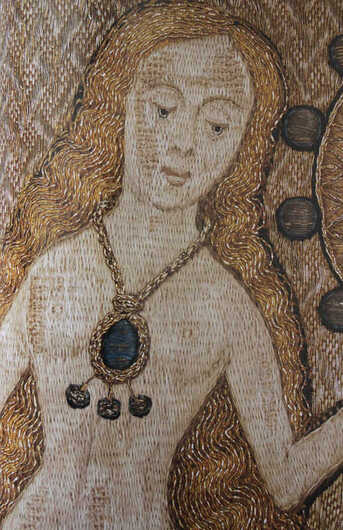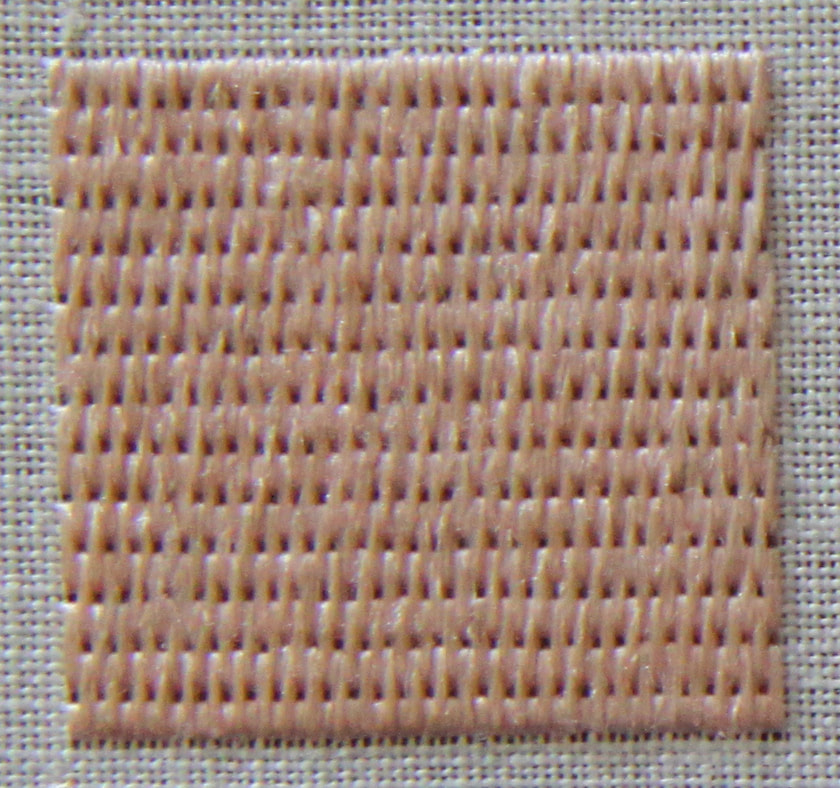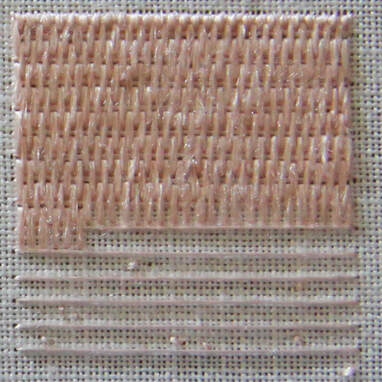|
Adding an area of Burden Stitch to my orphrey a couple of weeks ago resulted in some questions and remarks regarding this lovely stitch. First up was the name. A stitch in use during the Middle Ages should probably not be named after a woman who lived in the 19th century. Good point. However, renaming (well-known) stitches is a bit tricky. How do you safeguard that people still know what you are talking about? I could start calling Burden Stitch something like 'Brick Stitch over a foundation thread/padding'. That's technically what Burden Stitch is. Next question: Was Brick Stitch called Brick Stitch during the Middle Ages? I don't know. As far as I am aware, and please correct me if I am wrong, the only technique for which the name can be traced to French accounts of the High Middle Ages is or nue. We could sure do with a Re rustica or Re metallica for embroidery. No such luck. And then there was the mermaid ... This mermaid. She is lovely and a bit problematic. Typically mermaid I would say :). Due to a free reference to the website of a textile conservation company in an article by Natalie Dupuis for Piecework magazine, this mermaid is quite well-known in the embroidery world. It was later mentioned on Cynthia Jackson's blog too. After all, it is one of the few free online resources with good pictures of the embroidery. Neither Natalie nor Cynthia mentioned the Burden Stitch in their articles as they focussed on a completely different aspect of the Fishmonger's Pall. Burden Stitch is only mentioned on the website of the conservation company. And I think it is a mistake. The skin of the mermaid (and Saint Peter) is not stitched in Burden Stitch. Identifying embroidery stitches from photographs can be really tricky. When I was alerted to the 'Burden Stitch' on the Fishmonger's Pall by one of my Patrons, I eventually got confused too. When I looked at the pictures, I saw Brick Stitch, not Burden Stitch. As mentioned above, they are similar. Burden Stitch has an added foundation or padding thread. Most needle painting or long-and-short we see in medieval embroidery is actually Brick Stitch or something close to the orderly needle painting as seen in Chinese embroidery. Free-form needle painting as taught by the Royal School of Needlework or Trish Burr, simply does not exist. The medieval embroiderer was a master craftsman and not an artist. Free expression in embroidery was not invented yet. In order to better understand what was going on on the Fishmonger's Pall, I decided to stitch up some samples. I used 46ct even-weave embroidery linen with Chinese flat silk. In order to cover the fabric nicely, I do go over each stitch twice. This gives a flatter result than when you use a double thread in the needle. For my foundation threads, I used: Barkonie linen thread 50/2, a double thread of the Chinese flat silk, a single thread of the Chinese flat silk and gilt Stech 80/90 (passing thread). Burden Stitch produces a textured surface. To me, skin should be smooth. As you can see from my samples, even the single thread of silk produces a textured surface. Furthermore, it is really hard not to catch any fibres of the foundation threads (not so with the Stech). No matter if you use a sharp or a blunt needle. But my biggest argument why the stitch seen on the Fishmonger's Pall is not a Burden Stitch is the fact that you always see the foundation thread in Burden Stitch. And we do not see one in the pristine areas of the skin of the mermaid. This rules out Burden Stitch for me. The V&A catalogue for the Opus anglicanum exhibition does also not mention Burden Stitch. I, therefore, think that the conservation company misnamed the stitch. What do you think? Have I missed something? Very well possible! Please chime in below. I will also organise a Zoom meeting on Saturday the 3rd of June for my Master Patrons to further discuss the mermaid and my experiments. Let's see what we can learn!
Literature Browne, C., G. Davies & M.A. Michael (eds), 2016. English medieval embroidery Opus Anglicanum. London: Victoria & Albert Museum.
8 Comments
Joanne Brothers
29/5/2023 16:03:54
Thank you for the great pictures! I hadn't realized the foundation thread is in the center of the covering threads, with the stitches starting and ending close next to the foundation threads on either side.
Reply
29/5/2023 16:11:43
Me neither, Joanne. I really needed to stitch the samples to fully understand what the stitch does and how it works.
Reply
Alicia Clark
29/5/2023 16:51:11
I vote for some early form of split stitch (if that is even possible). This opinion is based on nothing more than my thoughts on seeing early examples of split stitch on faces that produced contour shading. However - no way of knowing unless you can get up close and personal with the piece with a microscope. Besides, what tecnique produced shading that is sometimes horizontal, sometimes vertical? Color me confused...
Reply
29/5/2023 17:11:48
Thanks for your comment, Alicia! Hmm, it can't be 'early' as this piece is indeed very late medieval :). And it isn't split stitch either. When I look at close-ups of split stitch that I took from medieval vestments, it looks like tiny chain stitches. You see the splitting of the silk clearly. No matter how small or big the stitches are. On the mermaid, the stitches touch pointy bit to pointy bit. There is no splitting. The stitch is clearly counted with the help of the background fabric. The shading is achieved horizontal and vertical. This is partly real and partly due to the lustre of silk and maybe even a little decomposition.
Reply
I think this is why we're nowhere near at the end of learning things about medieval embroidery!
Reply
5/6/2023 12:21:32
I completely agree, Rachel! I'll have medieval embroidery rabbit holes till the end of my days!
Reply
16/8/2023 06:07:41
Have you seen these fragments? the Embroidery on them is remarkably like the fishmongers pall, but older.
Reply
16/8/2023 09:11:49
Yes, I know these fragments, Tina. And I find their early dating a bit problematic :). And I don't think that they show the same embroidery as seen on the fishmongers pall. The later is mainly flat with a bit of padding, whereas the embroidery on these fragments from Brukenthal is proper stumpwork. Or am I missing something?
Reply
Your comment will be posted after it is approved.
Leave a Reply. |
Want to keep up with my embroidery adventures? Sign up for my weekly Newsletter to get notified of new blogs, courses and workshops!
Liked my blog? Please consider making a donation or becoming a Patron so that I can keep up the good work and my blog ad-free!
Categories
All
Archives
July 2024
|
Contact: info(at)jessicagrimm.com
Copyright Dr Jessica M. Grimm - Mandlweg 3, 82488 Ettal, Deutschland - +49(0)8822 2782219 (Monday, Tuesday, Friday & Saturday 9.00-17.00 CET)
Impressum - Legal Notice - Datenschutzerklärung - Privacy Policy - Webshop ABG - Widerrufsrecht - Disclaimer
Copyright Dr Jessica M. Grimm - Mandlweg 3, 82488 Ettal, Deutschland - +49(0)8822 2782219 (Monday, Tuesday, Friday & Saturday 9.00-17.00 CET)
Impressum - Legal Notice - Datenschutzerklärung - Privacy Policy - Webshop ABG - Widerrufsrecht - Disclaimer











 RSS Feed
RSS Feed